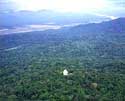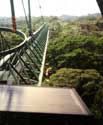
DESTINATIONS
Argentina
Belize
Bolivia
Brazil
Chile
Colombia
Costa Rica
Ecuador
El Salvador
Guatemala
Honduras
Nicaragua
Mexico
Panama
Paraguay
Peru
Uruguay
Venezuela
Multi-Country
AREAS
Amazon and Manu
Antarctica
Easter Island
Galapagos Island
Inca Trail
Pantanal
Patagonia
Panama Packages
The
Canopy Tower
Birdding Itinerary - 7 Days / 6 Nights
Day 1
Arrival in the evening, light dinner, introduction to Canopy Tower
, slide show of construction of Canopy Tower (subject to arrival time)
Day 2
Morning. Birding from the observation deck of the Tower, along Semaphore
Hill Rd.Visit to rainforest exhibit in ground floor of Canopy Tower
Lunch at the Canopy Tower
Afternoon: Birding in Plantation Trail .Dinner at the Canopy Tower.
Day 3
Morning. Birding along first half of Pipeline Rd.
Lunch at the Canopy Tower.
Afternoon: Birding in Summit Gardens, visit to Harpy Eagle Exhibit
Dinner at the Canopy Tower. Evening, owling in Semaphore Hill Rd. (optional)
Day 4
Morning. Birding along second half of Pipeline Rd.Picnic Lunch in
the forest.
Dinner at the Canopy Tower.
Evening, owling in Semaphore Hill Rd. (optional)
Day 5
Morning .Birding in Old Gamboa Rd North and South. Lunch at the Canopy
Tower
Afternoon: Visit to Miraflores Locks (Panama Canal).Dinner at Canopy
Tower
Evening, owling in Semaphore Hill Rd. (optional)
Day 6
Morning. Birding in Parque Metropolitano. Lunch at Canopy Tower
Afternoon: Visit to Smithsonian Tropical Research Institute Marine
Exhibit
Dinner at Canopy Tower. Evening, owling in Semaphore Hill Rd. (optional)
Day 7
Morning.Breakfast
*** End Of Our Services ***
| Prices
available upon request. Airport transfers, entrance fees to National Parks, to Summit Gardens and to Marine. Exhibit of the Smithsonian, bird watching guide, all meals, accommodation at the Canopy Tower, hotel tax and service. |
Explanation of birding locations
Observation Deck of the Canopy Tower
The Canopy Tower is a prime location from which to observe the birds and other wildlife of the forest canopy. Since they are right at eye level, it is usual to get fantastic views of birds you would hardly see otherwise. You don't have to leave the Tower to find birds; you don't even have to leave your bedroom! Tanagers and Tityras can be seen right from your window, and you don't have to worry about the rain. The dining area and the roof of the tower are better for finding elusive canopy birds, as well as Howler Monkeys, Tamarins and other mammals, since you can look in all directions around you. And all this without having to venture away from the Tower. But there's many other places to visit nearby, including the best birding spots in the Panama Canal Area.
Semaphore Hill Rd
You can start your explorations of the forests of Central Panama right on the road up Semaphore Hill. This paved road is a little more than a mile long, and passes through some of the forest protected by Soberanía National Park. Here you will get a chance to see birds and mammals that spend their lives closer to the forest floor, like antbirds and Agoutis. You can walk on the road, or use one of our modified observation vehicles, the Rainfomobiles.
At night, the forest seems to be a completely different world. More than eight species of Owls and Potoos have been seen on this road, and since most mammals are more active at night, it's usual to add a Two-toed Sloth or even a Rothschild's Porcupine to your owling list.
The bird list (see attachment) of Semaphore Hill Road is extensive, and includes birds from the forest interior as well as edge dwellers. Olivaceous Flatbill and White - whiskered Puffbird are common, and Slate-colored Grosbeak, Bay-headed Tanager, and Great Jacamar are seen frequently. Great Tinamou and Marbled Wood-Quail are heard often, but to see them takes a little more work. This road is also great for raptors: White, Tiny and Bicolored Hawks have been seen, and during migration it's easy to see more than 10 species of warblers and migratory songbirds in one morning. Spring migration is especially striking, as birds will be wearing their breeding plumages.
Old Plantation Trail
Old Plantation Trail, which starts right by the entrance to the tower, is a good, easy graded dirt road that passes through a mature forest for about four miles. The road follows a small creek, Río Chico Masambi, where sometimes a Louisiana Waterthrush spends the winter. In most places the forest is clear of undergrowth, which makes it especially suited for observing shy, interior forest birds like tinamous and leaftossers. Golden-crowned Spadebills are regular around the creek, and White-breasted Wood-Wrens are very easy to find. When visiting Plantation Road you also have a good chance to find an army ant swarm and many of the birds that follow these swarms as they roam the forest floor. Spotted, Bicolored and Ocellated Antbirds, Gray-headed Tanagers, and Plain-brown, Northern Barred and (if you're lucky) RuddyWoodcreepers.
And if you're really lucky you may even find a Hook-billed Kite.
Pipeline Rd.
Pipeline Road is the best place in Central Panama to find forest birds, and plenty of them. Eight species of wrens, five trogons, four puffbirds, three motmots, many antbirds and even more flycatchers have been reported from the road. And if its 17 Km are not enough, there's plenty of side trails plus eleven creeks and rivers that can be followed into the forest. Army antswarms are found frequently, attended sometimes by Rufous-vented Ground-Cuckoo, and there are many manakin leks right beside the road. Pipeline Road is also a great place for raptors: all three Forest-Falcons are heard if not seen with ease, and Tiny and Plumbeous Hawks and Ornate Hawk-Eagles have been reported a few times. A Harpy Eagle was seen one time right beside the road!
Summit Gardens
Summit Gardens is a park managed by the Office of the Mayor of Panama City. There is a small zoo where you can get a better look at King Vulture, Harpy Eagle, Great Curassow and four species of macaws, as well as Jaguar, Spider Monkeys,
and a host of other mammals. The botanical gardens are great for migratory warblers and other forest-edge species, and Blue Cotingas are seen every once in a while.
This is also the site of the Harpy Eagle Exhibit Center, a state of the art exhibit with great film clips of a Harpy hunting, a replica of a nest and other interesting aspects of the life of this most powerful raptor.
Old Gamboa South
Old Gamboa Road is, you guessed it, the old road to Gamboa, right at the start you'll see to Summit Ponds, where Boat-billed Herons nest and Capped Herons are seen every few years. Both Kiskadees, and both Green and Striated Herons are seen regularly, as well as the more common egrets. Going straight through the two ponds you'll be on one of the birdiest spots around. This road passes through a variety of habitats, and has plenty of specialties: Blue Ground-Dove, Great Antshrike, Jet Antbird, Black-tailed and Royal Flycatchers, Lance-tailed and Golden-collared Manakins and Rosy Thrush-Tanager are a few highlights.
Old Gamboa North
The forests on this end of the road are not fragmented, and are more similar to the ones on the Atlantic Slope. You may find Great Jacamar, Thrush-like Schiffornis and other birds that rarely get on the Pacific Slope.
All our tour packages include: Please click here


